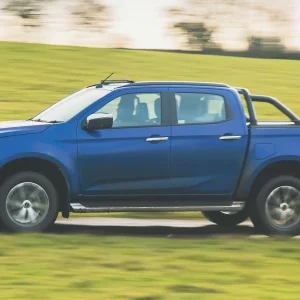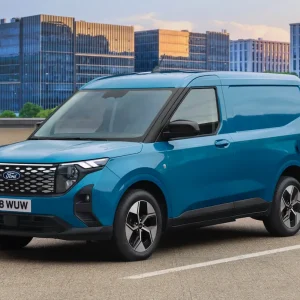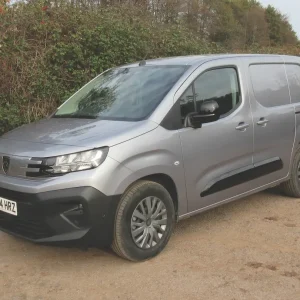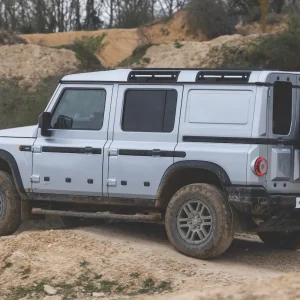Final Report
While the Ssangyong name may be unglamorous and unfashionable, the truck that bears its name has turned out to be a dependable workhorse that is comfortable to drive. Aside from a fuel flap that occasionally refused to close, it has manifested no faults at all.
It boasts a capacious cargo area that has swallowed all sorts of loads – including a large amount of timber – without complaint. The six-speed automatic box has delivered power smoothly, and the various on-board features can only be applauded.
Bitter winter weather caused me to appreciate the heated steering wheel and driver’s seat. The presence of Rear Cross-Traffic Alert prevented two collisions – one with a tractor, the other with a Toyota Prius – and Musso Rhino’s front and rear parking sensors and rear view camera with its remarkably-clear image made what is an undoubtedly bulky vehicle surprisingly easy to park.
Its 4×4 system proved effective when I had to cross a moderately-rutted field or two, and switching to the low-ratio set of gears enabled me to extricate myself from the sticky grip of deep, clinging mud on at least one occasion.
The four-wheel-drive and low-ratio set of cogs are easy to engage. All you need to do is twist a knob between the front seats.
Last year’s diesel shortage and consequent fuel rationing at service stations made me especially grateful to a button on the steering wheel, which I could flick to see how much range I had left and plan my trips accordingly.

Fuel economy isn’t Musso Rhino’s strong suit, although it improved to around 30mph during my time with it.
With the aim of maximising economy, and using a button next to the transmission lever, I selected the Eco setting most of the time, which was fine when I was lightly-laden. When I had a bit of weight on-board, however, and needed to tackle some of the steeper hills in Gloucestershire’s Forest of Dean, I opted for the Power setting instead; and enjoyed the extra punch it delivered without worrying too much about how much more diesel I might be burning.
The unladen ride certainly did not improve, although I was continually surprised by how well such a big, heavy, light commercial handled.
My Rhino was the immediate predecessor to the current one; the only real difference between the two is the different front-end styling. What is clear though is that Ssangyong must now implement a further update, which embraces more-sophisticated on-board safety systems such as Traffic Sign Recognition and Intelligent Speed Limiter; features that are to be found as standard on certain rival 4×4 pick-ups.
My view? While the manufacturer’s name may be a bit of a tongue-twister, anybody in the market for a vehicle of this type should consider visiting their local Ssangyong dealership. I doubt they will regret it.
End-of-term report
Safety – 4/5
While Rear Cross-Traffic Alert and the excellent rear view camera can only be applauded, Musso Rhino needs a more comprehensive safety package to keep it in contention.
Options list – 5/5
The only item that is listed for the new Musso Rhino is metallic paint. That is because the vehicle’s standard specification is so high. On that basis, I’ll have to give it our top score.
Driving – 3/5
No lack of performance, and it handles surprisingly well for such a big truck, but the unladen ride is poor and fuel economy could be better.
Load bay – 4/5
Roomy, easy to access and able to cope with a decent amount of weight.
Cabin – 5/5
A comfortable, well-equipped working environment that could scarcely be bettered.
Build quality – 4/5
Only one minor fault. Otherwise, to a very high standard.
Overall score: 83%
Ssangyong Musso Rhino pick-up
Mileage 3,169 miles
Official combined fuel economy (WLTP) 28.2mpg
Our average consumption 30mpg
Price (ex VAT) £30,035
Warranty 7yrs/150,000 miles
Service intervals 1yr/12,500 miles
Load length 1610mm
Load width (min/max) 1130mm/1570mm
Load bay height 570mm
Gross payload 1140kg
Engine size/power 2157cc, 181hp
CO2 262g/km
3rd Report
The mean streets of Britain’s major cities and towns are not the Musso Rhino’s natural habitat.
It’s a big truck when all is said and done, and it’s not ideally suited to bustling urban thoroughfares.
It is far happier pottering down country lanes behind combine harvesters than it is dicing with London buses and black cabs.
Light commercials are often obliged to be versatile, however, and on several occasions recently, Musso Rhino has been required to depart from the green fields of rural Herefordshire, and get among the chimney pots.
So how did it fare? Surprisingly well.
All-round glazing means that visibility is pretty good anyway, with Blind Spot Detection alerting the driver to any hazards he or she might have missed.
I’ve already praised Rear Cross-Traffic Alert for saving me from reversing into the path of a tractor. This time it stopped me from straying into the path of a Toyota Prius (must have been an Uber driver) as I backed out of a tight space in a congested underground car park.

Rhino’s front and rear parking sensors had helped me slide into the slot in the first place, while the remarkably-clear image delivered by the reversing camera ensured that I avoid swiping any concrete pillars as I extricated myself from it.
The front sensors also helped me squeeze down some painfully-narrow car park ramps without coming to grief.
Lane Change Assist proved useful on urban motorways, and the vehicle’s automatic transmission meant I could concentrate on what was going on around me without having to worry about which gear I should be in.
If I have any virtues then patience is not one of them, and I seethed with inner rage every time a Lycra-clad big-city cyclist cut in front of me. My inner (and never far from the surface) Mr Grumpy was further triggered by a suggestion flagged up on the instrument panel that I should take a break after I’d been driving for what was admittedly quite a while.
The advice was probably correct, but I still found it irritating.
Perhaps I should have remembered that the driver’s seat is fitted with a novel system that can cool it down whenever the temperature rises. That might have stopped me getting hot and bothered.
Having lavished praise on the Musso Rhino for its safety systems, here comes the bad news. What’s there is good, but it isn’t sufficient.
Even entry-level versions of Isuzu’s latest D-Max boast Intelligent Speed Limiter and Traffic Sign Recognition as standard, alongside Forward Collision Warning and Autonomous Emergency Braking. D-Max’s comprehensive safety package helped it clinch the What Van? Pick-up of the Year Award for 2022.
Our long-term-test Musso Rhino is of course the immediate predecessor of the one that has not long gone on sale, with differences in front-end styling distinguishing the two. Under the metal, however, they are virtually identical, which means they both have the same set of on-board safety devices.
Methinks that Ssangyong will have to introduce a refreshed safety package, and sooner rather than later, in order to remain competitive. That is especially the case if it is pitching what it has to offer to liability-conscious fleet customers who are obliged to treat safety as a priority.
In the meantime, I have clocked up getting on for 2,400 miles in Musso Rhino without any mishaps. It has proved reliable and average fuel economy has improved a little, to around 30mpg.
Flick a button on the steering wheel, and you can see how much range you have got left – a useful facility since, like all double-cab automatic pick-ups, it is not exactly frugal.
You can also review your tyre pressures and the level of AdBlue in the reservoir. I haven’t had to top it up yet, but it is of course early days.
With no tell-tale squeaks or creaks, build quality is not a cause for concern aside from the failure of the fuel flap to close properly. However, smacking it hard with the flat of my hand usually does the trick.
Report card: Build quality: 4/5
Ssangyong Musso Rhino pick-up
Mileage 2,393
Official combined fuel economy (WLTP) 28.2mpg
Our average consumption 30 mpg
Price (ex VAT) £30,035
Warranty 7yrs/150,000mls
Service intervals 1yr/12,500mls
Load length 1,610mm
Load width (min/max) 1,130mm/1,570mm
Load bay height 570mm
Gross payload 1140kg
Engine size/power 2157cc, 181hp
CO2 262g/km
2nd Report
How annoyed are you by all the safety devices that constantly flash and beep at you as you head down the highway? Yes, I know they are there to help ensure I don’t come to grief and injure other road users in the process – but they can be really irritating.
That, at least, was my view until I reversed our long-term-test Musso Rhino out of a field onto a quiet country lane. I had nobody to guide me so I had to trust my luck, reasoning that the lane concerned is never that busy.
The pick-up’s load area is long and capacious; a benefit I would otherwise applaud. If you are backing onto a road however, it also means the vehicle projects for some distance before you are able to see if anything is coming.
In my case, what was coming was a very big agricultural tractor hauling a trailer, and travelling at a fair rate of knots; Herefordshire tractor drivers take no prisoners. It would probably have slammed into me were it not for the fact that Musso Rhino is equipped with Rear Cross-Traffic Alert.
If you are reversing then it warns you if you are about to stray into the path of an oncoming vehicle. Thus alerted, I slammed the truck into forward gear; and catastrophe was averted.
This left me with another problem. I had hurtled so far forwards in my panicked attempt to avoid catastrophe that I had ended up in a waterlogged section of the field characterised by very deep, clinging mud.
I clearly wasn’t going to extract myself from my predicament in two-wheel-drive, so I twisted a knob between the seats to engage four-wheel-drive and a high-ratio set of gears. Doubting that would be sufficient (although in retrospect it probably would have been), I turned the knob further to engage the low-ratio gears – and after some momentary churning of a by-now-absolutely-filthy truck, it lurched out of the slough of despond and back onto terra fairly-firma.

I then did what I should have done in the first place – turned the pick-up round and somewhat gingerly departed from the field nose-first. My next stop was a service station with a pressure washer, and I decided to take the opportunity to fill up with diesel once
I’d blasted all the muck away.
That led me to my second problem of the day. Because there was a fuel shortage, the forecourt concerned was restricting fuel purchases to no more than £30 worth; and Musso Rhino is not the most frugal vehicle on the scene.
The official WLTP (World Harmonised Light Vehicle Test Procedure) fuel usage figure is 28.2mpg, which is about what I’ve been achieving. That is by driving gently for the most part, with the Eco for economy setting almost constantly engaged throughout.
I was planning to drive from Herefordshire to the furthest reaches of Cornwall and back with a couple of companions, but I realised I would struggle to make the round trip on a single tank of diesel; and feared that I might not be able to find any on my way back. So Musso Rhino languished at home in favour of something less thirsty, which was a pity.
It is after all a comfortable and roomy truck with heated leather-trimmed seats, a heated steering wheel and quality climate control.
On the other hand – and like most four-wheel-drive double-cab pick-ups – its ride when lightly-laden is not its strong suit. So a trek down to Cornwall under such circumstances might have proved to be a somewhat choppy one.
Going back to my wallow in a muddy field, it did not occur to me to switch the automatic transmission to manual. To do so all you have to do is push the shift lever over to the M setting, then flick a button on the lever’s side to go up and down the box.
Come to think of it, I do not recall resorting to the M setting at any point during the 800-plus miles I have driven the truck. I’ve started to wonder if it is really necessary…
Report card: Safety features = 4/5
One of the Musso Rhino’s strong points
Ssangyong Musso Rhino pick-up
Mileage 804mls
Official combined fuel economy 28.2mpg (WLTP)
Our average consumption 28.2 mpg
Price (ex VAT) £30,035
Warranty 7yrs/150,000 mls
Service intervals 1yr/12,500 mls
Load length 1,610mm
Load width (min/max) 1,130mm/1,570mm
Load bay height 570mm
Gross payload 1,140kg
Engine size/power 2,157cc, 181hp
CO2 262g/km
1st Report
The latest addition to our long-term-test fleet may not be with us for long. This is not because we are eager to part company with it – it’s simply because SsangYong’s Musso Rhino four-door double-cab 4×4 pick-up is in the process of being replaced by a facelifted model that has taken a bit of time to emerge.
In the meantime, we are driving its predecessor, but that does not invalidate our efforts. The facelift mainly consists of a new nose – everything else remains pretty much the same.
Rhino comes with a load bed 310mm longer than the one found on the standard Musso model, plus the same 181hp 2.2l diesel, with a six-speed automatic gearbox forming part of the Rhino package.
Only one level of trim is offered and features umpteen goodies; so many that I eventually lost count.
Both the front seats are electrically-adjustable and come with heaters plus a novel ventilation system that keeps them cool in hot weather. The height- and reach-adjustable steering wheel boasts a heater too.
A 9.2ins touchscreen is included in the deal, as is a DAB radio, Tom Tom satnav, Apple CarPlay, Android Auto, Bluetooth connectivity and MP3 compatibility. Dual-zone climate control and cruise control are fitted as well. The reversing camera delivers a remarkably clear image. The Rhino is by no means a minnow, but both the front and rear sensors make manoeuvring in confined spaces a doddle.
All the usual on board safety systems are present and correct, plus Rear Cross-Traffic Alert. It warns you if a vehicle is coming should you be backing out of an entrance into its path.
If everything goes pear-shaped then catastrophe need not necessarily ensue. Rhino comes with six airbags.
When turning to the automatic transmission, drivers can switch from auto to manual mode by moving the shift lever over to the M setting and then pressing a button on the lever’s side to go up and down the box.
Another button next to the lever allows Eco, Power or Winter settings to be selected.
Eco means you should enjoy better fuel economy in exchange for a reduction in performance. Power boosts the truck’s rate of acceleration, while Winter should deliver more grip on icy surfaces.
For a big truck Rhino handles surprisingly well, with no lurching or sliding all over the place as you push it through bends. Nor is it short on performance – particularly if your finger strays over to the Power button – with a remarkably effective kick-down facility allowing me to nip past the agricultural-tractor-plus-trailer combinations regularly encountered on Herefordshire’s dilapidated roads.
Rhino goes about its business quietly too, thanks in part to effective engine bay sound-proofing.
To select four-wheel-drive, you turn a knob between the seats that also enables you to select either a high- or a low-ratio set of gears. The set you choose depends on the off-road terrain you are facing and how arduous it is.
Like so many 4×4 pick-ups, Rhino rides poorly when unladen. On the positive side, the more weight you dump in the back, the better the ride gets.
So far as fuel economy is concerned, SsangYong quotes a combined WLTP (World Harmonised Light Vehicle Test Procedure) figure of 28.2mpg.
Not outstanding, agreed. At the end of the day however we are talking about a big, heavy truck with automatic transmission, so it is not going to deliver the sort of fuel returns one might expect from a diesel Ford Fiesta Van.
Nonetheless, it will be interesting to see if the figure can be improved on as I begin to pile on the mileage in the real world.
However, something that already stands out is Rhino’s remarkably-high build quality. It meets, and often exceeds, the standard set by better-known brands than South Korea’s SsangYong – something which should be applauded.
Report card: Cab = 5/5
Extraordinarily comfortable working environment
SsangYong Musso Rhino pick-up
Mileage 387
Official combined fuel economy 28.2mpg (WLTP)
Our average consumption 28.2 mpg
Price (ex VAT) £30,035
Warranty 7yrs/150,000 miles
Service intervals 1yr/12,500 miles
Load length 1,610mm
Load width (min/max) 1,130mm/1,570mm
Load bay height 570mm
Gross payload 1,140kg
Engine size/power 2,157cc, 181hp
CO2 262g/km





